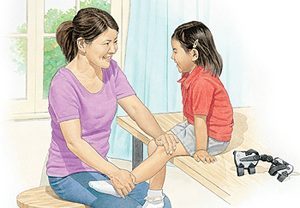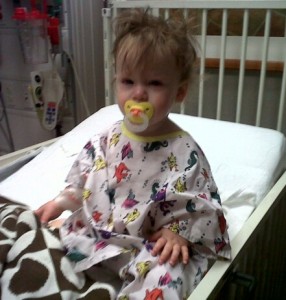
Parenting, Resources  In the hospital after the MRI[/caption]
Our story started when our daughter was 14 months. She had just learned to walk and as every parent knows those first steps are not the steps of a ballet dancer. We noticed that her walking was not very fluid and seemed unnatural. For a month or so we attributed it to her learning how to walk.
It was at that point that we noticed that when she woke up in the mornings her right leg was very stiff; her knee was very warm and a bit swollen. We waited a week to see if it would go away on its own. When that didn't work it was off to the doctor who promptly took a look and sent us straight to the emergency room.
In the emergency room our daughter was promptly prodded and poked all over. Blood was drawn, an IV was inserted and an MRI was taken. As you can imagine she was not a happy camper.
All of these tests were taken to rule out blood infections and other bad stuff. Once all the other possibilities were eliminated the consensus was that it may be juvenile rheumatoid arthritis.
In the hospital after the MRI[/caption]
Our story started when our daughter was 14 months. She had just learned to walk and as every parent knows those first steps are not the steps of a ballet dancer. We noticed that her walking was not very fluid and seemed unnatural. For a month or so we attributed it to her learning how to walk.
It was at that point that we noticed that when she woke up in the mornings her right leg was very stiff; her knee was very warm and a bit swollen. We waited a week to see if it would go away on its own. When that didn't work it was off to the doctor who promptly took a look and sent us straight to the emergency room.
In the emergency room our daughter was promptly prodded and poked all over. Blood was drawn, an IV was inserted and an MRI was taken. As you can imagine she was not a happy camper.
All of these tests were taken to rule out blood infections and other bad stuff. Once all the other possibilities were eliminated the consensus was that it may be juvenile rheumatoid arthritis.
Does my child have Juvenile Rheumatoid Arthritis?
Yesterday I came across a blog post written by Rob Gorski. Rob has a son, Emmet who has autism. After a lot of complaints from Emmet about his joints becoming very warm his doctor referred them to a Rheumatologist for the possibility of Emmet having Juvenile Rheumatoid Arthritis.Rob asked his readers if there are any specific questions that he should ask and are there any treatments they should avoid and why. As the father of a daughter with Juvenile Rheumatoid Arthritis (JRA) I was in a very similar position as Rob just a couple of years ago (read our story below). Instead of just leaving a comment with some tips on his post I have decided to share a number of questions you should ask your doctor as well as ways you can prepare for your first doctor’s visit. In addition we have included resources for additional reading as well as my family’s personal story. We would love to hear your input and advice as well. Please comment below.Juvenile Rheumatoid Arthritis: 12 questions to ask your doctor
1. Are you sure it’s JRA? JRA affects less than 300,000 children in the United States. That sounds like a big number, but that is less than one half of one percent of all children in the U.S. Until your Pediatric Rheumatologist confirms that it is JRA don’t be convinced that it is. There are a number of other conditions that have similar symptoms to JRA. 2. Pediatric Rheumatologist Make sure to see a Pediatric Rheumatologist instead of a regular rheumatologist. Pediatric Rheumatologists have a much better understanding of JRA and are experts on many arthritic conditions found in children. Be prepared: Pediatric rheumatology is a specialty within a specialty which means there are not many out there (the entire state of Michigan has less than 10). Be prepared to drive a little further and spend a little extra time in the waiting room. Find a Pediatric Rheumatologist near you or check out the best Pediatric Rheumatologists in the U.S. 3. Make sure you understand the diagnosis Juvenile Rheumatoid Arthritis (also called juvenile idiopathic arthritis –JIA) is only the general term for arthritis in children. There are actually seven different forms of arthritis in children and each type will be treated differently. Ask your doctor for a very clear explanation of what type of arthritis it may be and where you can find more reading material about it. 4. Spreading to multiple joints With JRA there is always the possibility of it spreading to other joints. Make sure to ask your doctor how to detect inflammation. If the arthritis does spread to other joints, the diagnosis and outlook may change. Make sure you discuss this possibility with your doctor 5. Treatment for JRA There may be different opinions on how to treat a particular patient with JRA and it will also depend on the type of JRA that is diagnosed. When you have a diagnosis, be sure to discuss a game plan with your doctor. Discuss what the initial treatment will be and what happens after it does or doesn’t work. Make sure you understand the process. 6. Family History of JRA The doctor may ask you if there is a family history of JRA, Chrohn’s or Celiac Disease (they are all autoimmune diseases). If you are not sure try and found out from family members if there are any close relatives that have had one of these conditions. This information will help your doctor with the diagnosis. 7. Length Discrepancy The fluid buildup in a joint (which may cause the warmth felt by Emmet) causes quicker bone growth. Make sure you discuss discrepancies in length between the affected and non-affected body parts (legs, arms, fingers etc.). If the knees or ankles are affected ask if physical therapy is necessary. 8. The Eyes Your doctor should bring it up but just in case he or she doesn’t make sure you do! One of the body parts that can be affected is the eyes (Inflammation of the eye is called uveitis). It is rare, but if left untreated it can be very dangerous. Ask your doctor about this and if there is a need to see an ophthalmologist. 9. Psoriatic Arthritis Psoriasis is a common skin condition that causes skin redness and irritation. One of the types of arthritis is Psoriatic arthritis. Up to 30 percent of people who have psoriasis will develop Psoriatic Arthritis. Make sure you know what psoriasis looks like or ask your doctor for an explanation. 10. Pretend it’s an interview Reporters would never be caught without a pen and paper! Act like a reporter and come prepared with a pen and paper and take notes. The doctor may throw a lot of technical jargon at you and even if they do explain things in layman’s terms there will be a lot of information to process, so be prepared. 11. Anything else you should know about? After your doctor finishes discussing your child’s diagnosis make sure to ask your doctor if there is anything else you need to know. While this may sound superfluous it forces the doctor to think through everything discussed and make sure that he or she covered everything. 12. Special Kids Health Care This is not a question for the doctor but someone in the doctor’s office should be know the answer to this. Visiting a pediatric rheumatologist is a very expensive endeavor. Luckily most states have special health care services for children and youth with increased risk for chronic physical and developmental conditions. If you are on Medicaid Special Kids Health will cover what Medicaid does not. If you have private insurance Special Kids Health Care will cover what your private insurance won’t at minimal or no extra charge.Juvenile Rheumatoid Arthritis Resources
Websites- Find a Pediatric Rheumatologist near you
- Top Pediatric Rheumatologists in the U.S.
- Juvenile Idiopathic Arthritus - Kid's Health
- Understanding Juvenile Rheumatoid Arthritis -- the Basics
- Treatments for JRA - Mayo Clinic
- Treatments for JRA - WebMD
- It's Not Just Growing Pains
- Juvenile Arthritis: The Ultimate Teen Guide
- Keeping A Secret: A Story About Juvenile Rheumatoid Arthritis
- Taking Arthritis to School
Our Story
Please Note: This is our personal story and may not be applicable to your situation. As there are many forms of JRA and each child is different the outlook will be different for every child. I am sharing this story simply so you can get an idea of what you may encounter in the future. [caption id="attachment_6163" align="alignright" width="286"] In the hospital after the MRI[/caption]
Our story started when our daughter was 14 months. She had just learned to walk and as every parent knows those first steps are not the steps of a ballet dancer. We noticed that her walking was not very fluid and seemed unnatural. For a month or so we attributed it to her learning how to walk.
It was at that point that we noticed that when she woke up in the mornings her right leg was very stiff; her knee was very warm and a bit swollen. We waited a week to see if it would go away on its own. When that didn't work it was off to the doctor who promptly took a look and sent us straight to the emergency room.
In the emergency room our daughter was promptly prodded and poked all over. Blood was drawn, an IV was inserted and an MRI was taken. As you can imagine she was not a happy camper.
All of these tests were taken to rule out blood infections and other bad stuff. Once all the other possibilities were eliminated the consensus was that it may be juvenile rheumatoid arthritis.
In the hospital after the MRI[/caption]
Our story started when our daughter was 14 months. She had just learned to walk and as every parent knows those first steps are not the steps of a ballet dancer. We noticed that her walking was not very fluid and seemed unnatural. For a month or so we attributed it to her learning how to walk.
It was at that point that we noticed that when she woke up in the mornings her right leg was very stiff; her knee was very warm and a bit swollen. We waited a week to see if it would go away on its own. When that didn't work it was off to the doctor who promptly took a look and sent us straight to the emergency room.
In the emergency room our daughter was promptly prodded and poked all over. Blood was drawn, an IV was inserted and an MRI was taken. As you can imagine she was not a happy camper.
All of these tests were taken to rule out blood infections and other bad stuff. Once all the other possibilities were eliminated the consensus was that it may be juvenile rheumatoid arthritis.
At The Pediatric Rheumatologist
After three days in the hospital with no clear diagnosis we were drained. The next step was trying to schedule an appointment with a Pediatric Rheumatologist. When we tried to schedule our first appointment the receptionist politely told us that the next available appointment was in four months. With some help from our doctor we were squeezed in for an appointment a few weeks after our hospital stay instead of a few months. At this point we received the definitive diagnosis of JRA.Medication
After consulting with the doctor on the different options of treatment our daughter began taking Naproxen, a nonsteroidal anti-inflammatory oral medication used to relieve symptoms of arthritis. As it seems with most medications there are side effects to Naproxen. Our daughter had some serious constipation and so Zantac was added to the mix to help give her stomach some relief.Arthrocentesis
The medications seemed to be helping, but at a very slow pace. After further consultation we opted for an arthrocentesis (a procedure in which a needle is inserted into the affected joint to drain fluids) and an injection of medication directly into the affected joint. At our next checkup we were happy to hear that the arthrocentesis had helped eliminate any signs of JRA in the knee. The bad news was that the doctor found that JRA had presented itself in the left knee and ankle. Due to the success of the arthrocentesis the first time around, we opted for it again. Unfortunately it didn't help this time and so we were back to the drawing board.Our Options
After another round of consultations we were presented with a few options. We could choose to stay on Naproxen, the original medication and hope that over time it would alleviate the symptoms. Our other option would be to move to a more powerful drug called methotrexate. We opted to keep with Naproxen for a few more months and see if there was any progress. At our next doctors visit there was no real progress and at that point we opted to move to methotrexate. We were very hopeful that using methotrexate would finally remove the symptoms from her knee and ankle and she would be JRA free. There are a lot of challenges when using methotrexate.- Injections Methotrexate is administered via injection. Once a week we had to give our daughter an injection, definitely not fun.
- More Medication The methotrexate is in addition to her other medications that she was already taking: Twice a day Naproxen and Zantac, once a day folic acid (to alleviate some of the side effects of methotrexate).
- The side effects of methotrexate Side effects include tiredness and moodiness and liver irritation. As methotrexate is a cancer chemotherapy drug (the dosages used in children with JRA are much smaller and therefore there are minimal serious side effects) she needs to take blood tests every three months to make sure her liver is not being affected.



